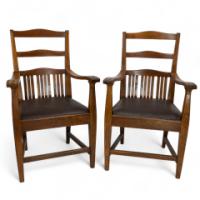Walter Frederick Cave (1863–1939) was an English architect, interior designer and furniture maker active from the late Victorian period into the inter-war years. Born in Clifton, Bristol, he trained at the Royal Academy Schools and was articled to Arthur Blomfield before opening his own practice in London in 1888–89. His early work was rooted in the Arts and Crafts tradition, later moving towards a more restrained Edwardian Classicism. Cave joined the Art Workers’ Guild in 1889 and designed not only houses but their interiors, including panelling, fireplaces, furniture and fittings.
By the early twentieth century Cave was an established figure in the profession, elected FRIBA in 1906 and serving as Vice-President of the Royal Institute of British Architects from 1917 to 1921. Alongside domestic and ecclesiastical projects he designed metalwork and furniture exhibited with the Arts and Crafts Exhibition Society, and produced art-case pianos for C. Bechstein that combine simple architectural structure with carefully judged ornament. His work forms a bridge between late nineteenth-century Arts and Crafts ideals and the more formal interiors of the Edwardian period.


